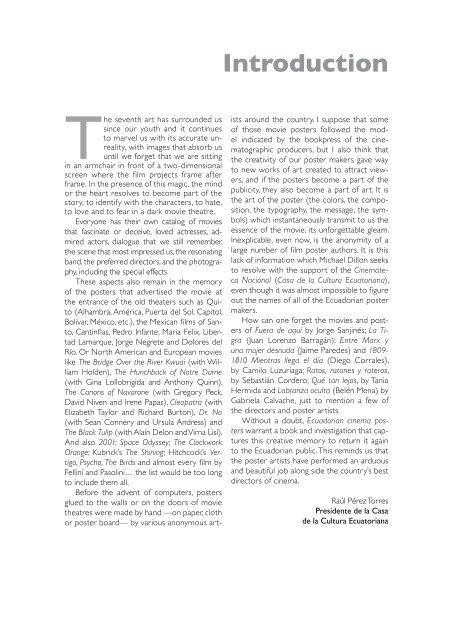Michael Dillon
afichesdecineecuatorianomc00
afichesdecineecuatorianomc00
- No tags were found...
You also want an ePaper? Increase the reach of your titles
YUMPU automatically turns print PDFs into web optimized ePapers that Google loves.
IntroductionThe seventh art has surrounded ussince our youth and it continuesto marvel us with its accurate unreality,with images that absorb usuntil we forget that we are sittingin an armchair in front of a two-dimensionalscreen where the film projects frame afterframe. In the presence of this magic, the mindor the heart resolves to become part of thestory, to identify with the characters, to hate,to love and to fear in a dark movie theatre.Everyone has their own catalog of moviesthat fascinate or deceive, loved actresses, admiredactors, dialogue that we still remember,the scene that most impressed us, the resonatingband, the preferred directors, and the photography,including the special effects.These aspects also remain in the memoryof the posters that advertised the movie atthe entrance of the old theaters such as Quito(Alhambra, América, Puerta del Sol, Capitol,Bolívar, México, etc.), the Mexican films of Santo,Cantinflas, Pedro Infante, Maria Felix, LibertadLamarque, Jorge Negrete and Dolores delRío. Or North American and European movieslike The Bridge Over the River Kwuai (with WilliamHolden), The Hunchback of Notre Dame(with Gina Lollobrigida and Anthony Quinn),The Canons of Navarone (with Gregory Peck,David Niven and Irene Papas), Cleopatra (withElizabeth Taylor and Richard Burton), Dr. No(with Sean Connery and Ursula Andress) andThe Black Tulip (with Alain Delon and Virna Lisi).And also 2001: Space Odyssey; The ClockworkOrange; Kubrick’s The Shining; Hitchcock’s Vertigo,Psycho, The Birds and almost every film byFellini and Pasolini… the list would be too longto include them all.Before the advent of computers, postersglued to the walls or on the doors of movietheatres were made by hand —on paper, clothor poster board— by various anonymous artistsaround the country. I suppose that someof those movie posters followed the modelindicated by the bookpress of the cinematographicproducers, but I also think thatthe creativity of our poster makers gave wayto new works of art created to attract viewers,and if the posters become a part of thepublicity, they also become a part of art. It isthe art of the poster (the colors, the composition,the typography, the message, the symbols)which instantaneously transmit to us theessence of the movie, its unforgettable gleam.Inexplicable, even now, is the anonymity of alarge number of film poster authors. It is thislack of information which <strong>Michael</strong> <strong>Dillon</strong> seeksto resolve with the support of the CinematecaNacional (Casa de la Cultura Ecuatoriana),even though it was almost impossible to figureout the names of all of the Ecuadorian postermakers.How can one forget the movies and postersof Fuera de aquí by Jorge Sanjinés; La Tigra(Juan Lorenzo Barragán); Entre Marx yuna mujer desnuda (Jaime Paredes) and 1809-1810 Mientras llega el día (Diego Corrales),by Camilo Luzuriaga; Ratos, ratones y rateros,by Sebastián Cordero; Qué tan lejos, by TaniaHermida and Labranza oculta (Belén Mena) byGabriela Calvache, just to mention a few ofthe directors and poster artists.Without a doubt, Ecuadorian cinema posterswarrant a book and investigation that capturesthis creative memory to return it againto the Ecuadorian public. This reminds us thatthe poster artists have performed an arduousand beautiful job along side the country’s bestdirectors of cinema.Raúl Pérez TorresPresidente de la Casade la Cultura Ecuatoriana


